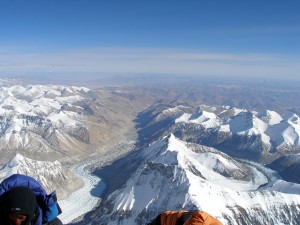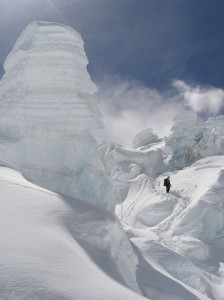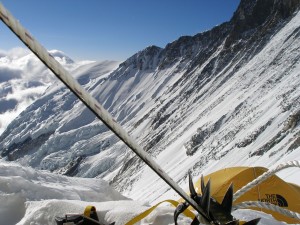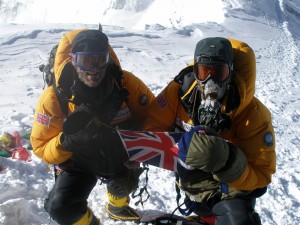News
SE Ridge on Everest – 2006
11 July 2006
Two years on, in April 2006, I had put together another team, secured sponsorship and was set to attempt the SE Ridge from the Nepalese side of the mountain. Even though it was my second time on Everest, it felt completely different as we were on another route. We arrived in Kathmandu on April 3rd and were greeted by the usual hustle and bustle of this magical city. After a day of organising and packing, our main bags were sent up by helicopter and yak and we flew to Lukla, a tiny airstrip high in the hills where our trek to Base Camp was to begin. Much had changed in the six years since my last visit; the airstrip had been tarmacked, many new lodges had sprung up and some of the precarious rope bridges had been re-built in steel. It took us ten days to reach Base Camp as we had to allow our bodies to acclimatise to the thinner air at altitude. This takes time and patience. Dehydration is a major problem up high and so we made sure we drank at least 4 or 5 litres each day. Headaches were also a problem so we took aspirin daily to thin the blood.
Base Camp (5,200m) is situated on a glacier at the bottom of the notorious Icefall. We each had our own tent where we could spread out and rest. It was like living in a quarry with the continuous sound of avalanches sweeping down the valley sides. This was quite worrying at first but one soon became used to it. There was also the continuous sound of the glacier which was constantly moving and creaking beneath us. The loo was a nearby crevasse; there was a kitchen tent and a mess tent where we spent most of our time playing monopoly and cards! Sete Bica and Jaget Rai were our cooks and they made sure we were never hungry! We ate a lot of rice, soup, pasta, yak steak and fresh vegetables. We often had eggs or porridge for breakfast and sometimes even yoghurt! Altogether, there were about 17 teams on the mountain, most climbing Everest but a handful of teams were attempting Lhotse (4th highest peak in the world).
After a couple of days at Base Camp it was time to venture into the Icefall for more acclimatisation. We went up about 300m and crossed some crevasses on ladders before returning to Base Camp for more rest. Three days later we went up a further 600m before coming back down. All this is vital for the body to adjust – if one tries to rush the process then the risk of becoming sick later in the expedition is far greater. The next time we pushed the whole way through the Icefall and spent 2 nights at Camp 1 and on one of those days we climbed up through the Western Cwm to Camp 2 where the Sherpas were constructing a kitchen and a mess tent – this was to be our ‘Advanced Base Camp’.
The Icefall is a frighteningly unstable place and one of the most dangerous parts of the climb. There are ‘bottomless’ crevasses everywhere and unstable blocks and seracs of ice just waiting to fall. Three Sherpas, working for another expedition team, were killed when the top half of the Icefall collapsed on them at the beginning of the expedition at 7.30am one morning – it could have happened to any of us. There was a line of them and we knew Ang Sering Sherpa who was directly behind the three who were killed. He was so distraught and shocked by the accident that he dropped his rucksack there and then and ran all the way out of the Icefall and back to his home in Pangboche further down the valley, telling us that he would never return to work on Everest. It was horrific and it caused two of our team to return home as well. The best time for climbing through the Icefall is in the early hours of the morning when the ice is hard and stable. Alarms would be set for 4am followed by tea and porridge. Sherpas entering the Icefall could be heard chanting prayers asking the mountain gods to protect them, some would smoke and the sweet smell of burning juniper filled our nostrils as we walked through the numerous camps to the start. The smoke is believed to carry their prayers up into the heavens. It is quite eerie particularly as no one really says much; one just concentrates and gets on with moving steadily through the ice. I found it easiest to get into a rhythm and to try and stick to it. I concentrated on putting one foot in front of the other and being sure to clip onto the fixed lines. A team of ‘Ice Doctors’ had the dangerous job of making sure the Icefall was in good condition for the climbers. They would check the anchors, the ice screws and the lines. Each time we passed through the Icefall it was different, parts collapsed, ladders bent, new crevasses and ice cliffs formed – I always felt nervous going through the Icefall and my mouth was often dry! By the end of the expedition we had passed through it a total of ten times!
Camp 2 at 6400m is situated about two hours climb from the foot of the Lhotse Face. It is in a beautiful position at the top of the Western Cwm with views down the valley below the towering sides of the western flanks of Everest and Nuptse. Walking up the Cwm was exhausting as it just went on and on and Camp 2 never seemed to get any closer. The camp was set out in a similar way to Base Camp where we had a mess tent and a kitchen tent where Pasang Temba and Ang Sherpa cooked us up some amazing food. Ben and I shared a tent from here onwards. We have done all our climbing together in the past and it is always good to have a soul mate on these types of expedition to share the experience. Ben is quieter and more reserved than me. I am perhaps a little more gung-ho in making decisions but, as we are so different, we complement each other well. Overall, we spent about two weeks at Camp 2, venturing up to Camp 3 which is half way up the Lhotse Face with even more stunning views of Cho Oyu (6th highest mountain 8200m) and Pumori. The Lhotse Face is quite steep; in parts it was up to 60 degrees. Most of it is hard, blue ice. If you are not clipped in then one slip would almost certainly be fatal. A Czech climber who was climbing Lhotse slipped over 800m while he was in the couloir – he was found the next day in a coma having been out all night. He died a few hours later. As Reinhold Messner once said, “Mountains are not fair or unfair – they are dangerous”. Camp 3 at about 7300m was a cramped and windy place. Our tents were at the very top of the camp below the Yellow Band. The floor of our tent was curved due to the heat of our bodies melting the snow beneath us. It was like sleeping in a hammock and very uncomfortable, particularly as it was full of oxygen bottles and spare tents etc. It was damp and cold when we got there so we put on our down suits which warmed us up immediately. We had our little gas stove melting ice continuously as we had to keep drinking. We peed into bottles to avoid going out into the freezing winds outside. It was easier this way! Immodium came in useful too!
From Camp 3, on our second visit, we started breathing bottled oxygen on our way up to the South Col. As soon as one puts an oxygen mask on there is a notable difference – things become easier and one moves faster. We climbed up the Yellow Band, a rocky band of yellow rock above Camp 3 and then moved steadily upwards to the Geneva Spur which is a steep traverse on snow leading to the South Col. Once on top of the Geneva Spur, the terrain levelled out a little and half an hour later I was on the snowy Col at just under 8000m. I was the first there and waited for the Sherpa team and others to join me as they had the tents. They arrived an hour later and I helped them put the tents up. The wind increased and it started to snow. I was concerned as we were leaving for the summit that night at 9pm. We spent a number of hours resting and melting more ice. There were four of us in a two-man tent now which was even more uncomfortable and cramped. The weather cleared and at 7pm we started to get ourselves prepared for the climb to the summit. At this height it took us about two hours to get ready as we moved slowly and our brains were also slow due to the extreme altitude. Outside the temperature was dropping and inside the tent it was about -30°C already! At 9.15pm we set off. I felt uncomfortable and tired. My back was aching after being in cramped conditions for so long. I just did not feel ready. We paused after every two steps and I thought, “At this rate we won’t make it as we are moving too slowly”. My legs were screaming at me to stop but my mind told them to continue! After a couple of hours we reached the fixed ropes and clipped in with our jumars (ascending devices which move up the rope but not down). After another two hours my jumar had frozen and wasn’t gripping the rope as it should so I had to keep prodding it with my crampon spikes to free it up. My oxygen mask was also freezing up as it was now about -50°C with wind-chill. I took my thick mittens off to try and do something about it. My hands instantly became cold and numb but I had to fix my mask or my climb would have ended there. After half an hour I was shivering. I was now at about 8400m and in trouble. I radioed down to base where they told me to send Topchen, my sherpa, down to Camp 4 but to take his mask and oxygen, which I did. I immediately felt my body warming up with the oxygen and carried on to catch Ben who was waiting for me at the Balcony. We then continued steadily upwards, with Pansang Dawa Sherpa who was Ben’s sherpa. The moon and stars showed us the way. Makalu was behind us glimmering in the dim light, we could see electrical lightning storms in the distance but our hypoxic minds did not seem to worry! Just below the South Summit, Ben had the same problem with his mask and upon closer inspection it had frozen solid. We drilled a hole in it with a penknife and tried to bypass the valves by sticking the pipe into the new hole. It was basic but it seemed to work. When we reached the South Summit I knew we would make it. I felt strong and there was the summit. I felt a rush of adrenaline. The Hillary Step was right there in front of us and, on our right hand side, the Kangshung Face fell 5000 or 6000m away beneath us. We climbed the corniced summit ridge, the famous Hillary Step and then plodded slowly up to the summit. I tapped Ben on the leg and with tears in my eyes said, “This is it! We just have to get down now!” He turned to me and squeezed my hand, also with tears of joy and said nothing. He didn’t need to.
We were standing on the summit with the world at our feet. It was the most magical feeling I have ever experienced and certainly one I shall remember forever. All those years of dreaming had come true. We could see for miles and miles into Tibet and all over Nepal. We pointed out the mountains we had climbed, we took photos and some video footage which all required huge effort. The wind was increasing and after about 35 minutes we turned to make our way down, taking extra care not to make any mistakes. It was exhausting but we reached the Col after about 6 hours. We had not slept and the summit climb had taken about 17 hours. Upon reaching the tents, we collapsed and dozed for a few hours, unable to do anything.
Two days later we were safely at Base Camp. I don’t think I can recall having ever been so exhausted! I suffered from three frost-bitten blackened finger tips on my right hand. This was caused when I took my gloves off to try and fix my mask. Ben suffered from very badly frostbitten toes on his left foot. At the time of writing we are not sure whether he will lose some or not. It will be another 5 months until we know!
Tom Clowes




